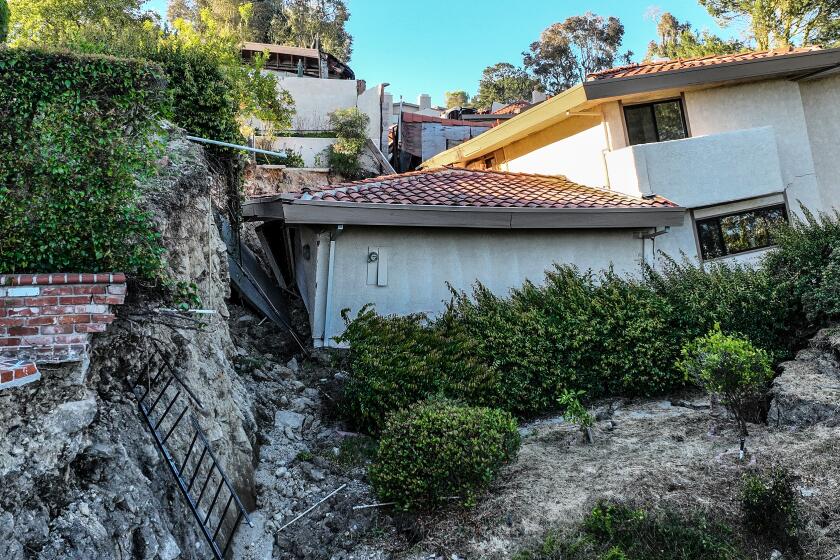California home insurers plan return to fire zones under new deal

- Share via
After a summer that saw many of California’s top home insurers pull back from the state market, Insurance Commissioner Ricardo Lara announced Thursday that he struck a deal with the insurance industry to encourage new coverage in the state.
Insurers, Lara said, agreed to return to the high-risk fire zones in the hills and canyons of California in exchange for a number of concessions that will make it easier, in theory, for them to get higher rate increases through the state regulator more quickly. The announcement comes the week after negotiations in Sacramento over a legislative response to the home insurance market fell apart.
The deadline for a deal to address the home insurance market came and went in the California Legislature, but the problem persists.
Gov. Gavin Newsom also issued an executive order on Thursday afternoon commanding the insurance commissioner to “take prompt regulatory action to strengthen and stabilize California’s marketplace” and consider whether emergency action could be necessary.
The changes are slated to go into effect by the end of 2024, but the hope is that insurers will return to writing new homeowners policies in California sooner. Leading insurers such as State Farm, USAA and Allstate all have requests for rate increases pending with the state insurance department, and are requesting hikes of 28.1%, 30.6%, and 39.6%, respectively.
If approved, each company would be allowed to raise its total premiums in the state by that amount, but the rate increase can be distributed differently among homeowners: a cabin in the woods might see a 200% jump while a home in San Francisco could see little to no change.
Since the massive fire years of 2017 and 2018, home insurers have been gradually withdrawing from the most fire-prone parts of the state. As a last resort, homeowners and businesses in those areas have turned to California’s FAIR plan, a backstop insurance provider funded by the companies that do business in the state, which charges much higher rates to provide less coverage in high-risk areas. The result of this pullback can be seen in the numbers: the number of FAIR plan customers more than doubled since 2018, up to 3% of the total state market.
Under this new deal, insurers have agreed to return to those fire risk zones up to a certain threshold equivalent to 85% of their statewide market share. That means State Farm’s California home insurance branch, which covers over 21% of the state market, would be required to cover 18% of the houses in fire zones. The net effect will be that major insurers will combine to cover 85% of customers in those areas, with the FAIR plan and other higher-cost insurers picking up the remaining 15%.
As a Rolling Hills Estates hillside further collapses, homeowners without special coverage are unlikely to get any financial assistance from their home insurers.
In exchange, Lara has offered to loosen certain elements of insurance regulation in California. The Personal Insurance Federation of California, an insurance trade association, gave the deal its blessing in a statement following Lara’s announcement.
“It is painfully clear the current system is not working properly,” wrote Rex Frazier, president of the PIFC. “Today’s actions are an important first step in stabilizing California’s insurance market.”
Under the existing system, insurers need to apply to the Department of Insurance to raise their average rates across the state, and provide reams of supporting documents to justify the price hike. The process also allows for consumer advocates to intervene along the way to serve as watchdogs in the process.
This system was created in 1988, when California voters approved Proposition 103, and the first elected commissioner on the job, current congressman John Garamendi (D-Walnut Grove), put a regulatory regimen in place above and beyond the text of the ballot measure. Those rules meant that insurance companies were not allowed to pass along the cost of reinsurance — insurance policies that insurance companies buy to cover their big losses — to policyholders, and that they could use only historical loss data, rather than forward-looking simulations, to request permission for a price hike.
Insurance industry representatives have been clamoring for both of those rules to be abolished for years, with the calls intensifying this summer as major insurers hit pause on writing new business in the state, citing rising reinsurance and catastrophic loss costs — though they said the spiking cost of materials and labor for home repair and rebuilding also played a major part in their financial strain.
Now, Lara said, he plans to go ahead and allow insurers to use catastrophe modeling that takes into account the projected impacts of climate change and other shifting factors when asking to raise rates. He also said that insurers will be allowed to include reinsurance costs for California coverage into rate filings, though the announcement did not go into specifics. Companies will be allowed to use these models only if they comply with their commitment to increase coverage in the state and reduce the FAIR plan population.
Lara also said that the insurance department finalized a change to the FAIR plan, first announced months ago, which increases the dollar amount that the plan is allowed to cover for commercial properties. Before, it was capped at $7.2 million to $8.4 million for different types of commercial properties, which include condo associations, homeowners associations, affordable housing developments, and businesses such as wineries that are often located in areas with high fire risk. Now, that cap has been raised to $20 million for all types of commercial properties.
Lara also said he aims to speed up the overall process by accelerating the pace of rate approvals, and that the new state budget includes funds for hiring more staff to process filings. On Friday, the department of insurance also took the step of publishing data on recent watchdog interventions in rate filings, including the amount of compensation that groups were awarded for their advocacy work, which Lara argues will increase transparency and make it easier for more consumer advocates to participate.
The consumer advocates in question were mixed on the announcement.
Amy Bach, executive director of United Policyholders, said in a statement that the deal “directly addresses the problems we have been hearing from residents and business owners, which are rooted in drastically reduced access to insurance.”
But Consumer Watchdog, the consumer advocacy group that serves as intervenor in the majority of rate filing cases, fundamentally disagrees with Lara’s approach.
The group wrote a letter to Newsom earlier Thursday urging him against declaring a state of emergency to give Lara the power to change the regulations with a lower degree of public comment.
“Insurance Commissioner Lara should not be trusted with these extraordinary powers,” the group wrote, noting that he has refused to meet with consumer advocates, spent the summer in conversation with industry lobbyists, and is under investigation for campaign finance law violations by the California Fair Political Practices Commission.
Harvey Rosenfield, the author of Proposition 103 and founder of Consumer Watchdog, said that he and his colleagues were waiting to see the text of the proposed rules before formulating a full response, but that Lara largely “parroted industry talking points” to promote policies that could “lead to extremely high increases in people’s insurance bills.”
Rosenfield and other consumer advocates have argued that forward-looking catastrophe models amount to a black box that insurers can use to manipulate their rate requests without showing their math.
At past hearings, participants have raised the idea of creating a shared, transparent state-administered model, or imposing auditing and transparency requirements on the companies developing the models. But modeling companies have argued that too much transparency would amount to a violation of their competitive edge and trade secrets. It remains unclear exactly how Lara plans to thread this needle.
The same criticism holds for reinsurance costs, which are subject to an unregulated global market — allowing companies to pass them through would amount to a loophole in California’s strong price control system, according to consumer advocates.
Rosenfield added that Lara’s new transparency requirements were a welcome change. “We’ve been asking to publish all the information that goes through the agency for years,” he said. After the department published the data on intervenors Friday, Rosenfield added that transparency “has to include the communications between the insurance companies and the insurance commissioner and his staff” when discussing rate increases.
He also noted that there was no agreement in writing with the insurance companies as part of this deal — and questioned whether the industry would follow through on its part of the bargain. “He said the industry promised to behave itself” in so many words, Rosenfield said. “Anybody who believes that is a fool.”
More to Read
Inside the business of entertainment
The Wide Shot brings you news, analysis and insights on everything from streaming wars to production — and what it all means for the future.
You may occasionally receive promotional content from the Los Angeles Times.












